Physical Address
304 North Cardinal St.
Dorchester Center, MA 02124
Fractures of the distal radius are extremely common, accounting for one-sixth of all fractures seen in emergency departments (EDs). The greatest frequency occurs in two age groups: those 6 to 10 years of age and those between 60 and 69 years old. These fractures occur more commonly in women than in men, increase in frequency with advancing age, and result from low-energy falls more often than from high-energy trauma.
Although Colles first described the distal radius fracture in 1814, considerable controversy remains regarding the classification, appropriate treatment, and anticipated outcome of these injuries. Colles initially stated that the wrist would eventually gain “perfect freedom in all of its motions and be completely exempt from pain” after this fracture. This perpetuated the concept of distal radius fractures as a homogeneous group of injuries that could be treated nonoperatively with an expected good functional outcome.
It is now appreciated that well over half of these fractures involve either the distal radioulnar or the radiocarpal joint and that conventional reduction by traction or manipulation may not restore distal articular anatomy. Furthermore, many of these fractures, although initially reducible by manipulation, may be inherently unstable and may collapse with simple cast immobilization. As recent reports have confirmed a direct correlation between late functional results and residual deformity, especially in younger, more active patients, the emphasis has shifted toward efforts to surgically restore acceptable alignment as necessary, especially in this patient demographic. The advent of anteriorly applied locking plates has revolutionized the treatment of these injuries, allowing for stable fixation with an earlier rehabilitation and recovery of motion and function for many fracture types. Despite the popularity of volar plate fixation, other means of fixation such as external fixation, fragment-specific fixation, and dorsal bridge plating are useful for specific types of fractures and are important parts of wrist surgeons’ armamentarium.
The distal end of the radius forms the anatomic foundation of the wrist joint. The flare of the radial metaphysis begins approximately 2 to 3 cm proximal to the radiocarpal joint. The articular surface of the distal radius is divided into two articular facets for the scaphoid and lunate by a longitudinal sagittal ridge ( Fig. 42.1 ). The ulnar surface of the distal radius has a separate articular facet, the sigmoid notch, for the seat of the ulna. It is here that forearm rotation takes place as the radius and carpus rotate around the ulna. The triangular fibrocartilage spans from the distal edge of the radius to the base of the ulnar styloid process, stabilizing the distal radioulnar joint (DRUJ) and supporting the ulnar carpus.
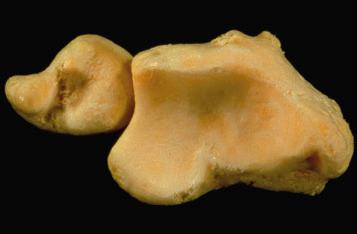
The normal distal radius articular surface inclines radially between 22 and 23 degrees in the frontal plane ( Fig. 42.2 ). The joint surface slopes palmward between 4 and 22 degrees, with an average palmar inclination of 10 to 12 degrees. This is best appreciated on a true lateral radiograph. Radial length refers to the distance between the tip of the radial styloid process and the distal articular surface of the ulnar head. The average radial length is 11 to 12 mm. Ulnar variance is the relative length between the head of the ulna and the articular surface of the distal radius. This measurement must be taken from a neutral rotation posterior-anterior (PA) radiograph because forearm rotation affects the relative length from the distal radius to the ulna. The average ulna and radius end within 1 mm of each other. These anatomic parameters have become well accepted in the radiographic evaluation of distal radius fractures (see Fig. 42.2 ).
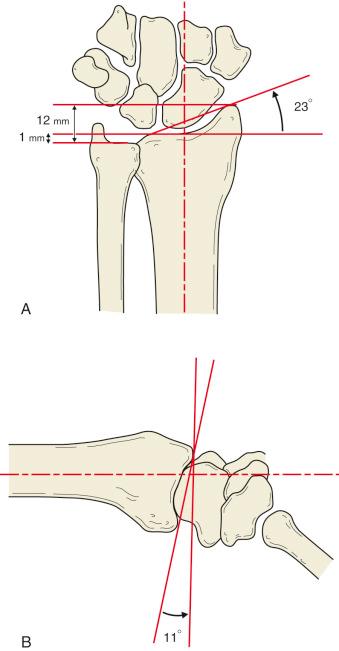
Since the 1960s, a number of classification schemes have been developed in an attempt to describe more accurately the variety and extent of fracture patterns of the distal radius, and these have attempted to move away from the many eponyms (Colles, Smith, Barton, etc.) that often oversimplified these injuries. In 1967, Frykman established a system of classification that identified involvement of the radiocarpal and DRUJs as well as the presence or absence of a fracture of the ulnar styloid. This system fails to identify the extent of intraarticular injury or the degree of displacement or dorsal comminution. Simple low-energy fractures with minimal angulation and shortening are classified together with high-energy fractures that involve multiple displaced fragments. This system, therefore, has little value as a treatment guide or a predictor of outcome.
Jupiter and Fernandez developed a more useful classification based in part on the mechanism of injury. It reflects a better understanding of the various fracture patterns:
Bending —failure of the metaphysis under tensile stress, with the distal fragment directed more commonly dorsally than volarly
Compression —fracture of the inner aspect of joint surface with impaction of subchondral and metaphyseal bone (die punch)
Shearing —often partial articular impacted fractures at the periphery of the joint surface (i.e., dorsal or volar rim)
Avulsion —fractures of ligament attachments (ulna, radial styloid)
Combinations of 1 through 4—high-velocity injuries
Melone introduced the concept that fractures of the distal radius often follow a similar pattern with respect to intraarticular fragmentation, with four basic components of these fractures: (1) the radial shaft, (2) the radial styloid (scaphoid facet of the distal radius), (3) the dorsal aspect of the lunate fossa, and (4) the palmar aspect of the lunate fossa. The lunate fossa fragments are pivotal to both radiocarpal and DRUJ function and are termed the medial complex. A large percentage of so-called extraarticular fractures have nondisplaced intraarticular components that occur within these guidelines, the most common of which involves the dorsal aspect of the lunate facet. For the purposes of this classification, a part is defined as a fragment of bone of sufficient size to be functionally significant and capable of being manipulated or internally fixed.
The most detailed of the classification systems is the Arbeitsgemeinschaft für Osteosynthesefragen (AO) system ( Fig. 42.3 ). This scheme is organized in order of increasing severity of the osseous and articular lesions. The classification divides distal radius fractures into extraarticular (type A), partial articular (type B), and complete articular (type C). Each type is then subdivided into groups (simple vs. complex for the articular and metaphyseal segments). These groups, in turn, can be further subdivided into subgroups, reflecting the morphologic complexity, difficulty of treatment, and prognosis. Several studies have shown reliability and consistency in the ability of different assessors to agree on fracture type but to a lesser extent on group and subgroup (see Fig. 42.3 ). Unfortunately, despite multiple attempts at generating comprehensive classification schemes for distal radius fractures, both the intraobserver and interobserver reliability of the systems remain fair to moderate. This is likely because of the bony complexity of the distal radius and the variability of injury. Regardless of the classification system, computed tomography (CT) scans can be very useful in better understanding the fracture pattern, especially in less experienced observers.
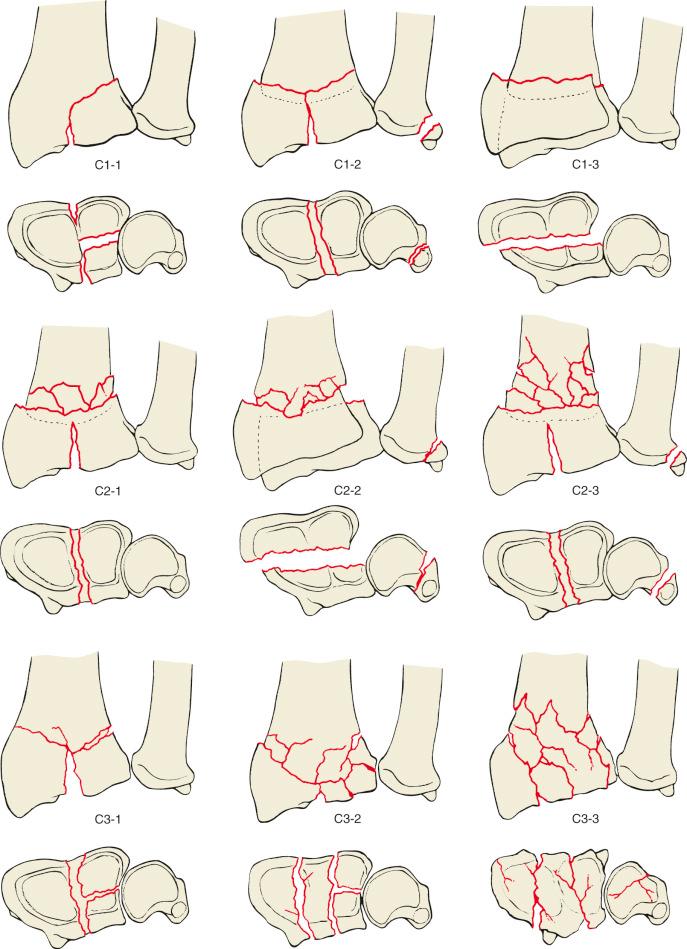
We believe an ideal classification system incorporates aspects of each of the previously described systems. Considering the anatomic type using the number of fracture “parts” is a quite useful system in identifying the common fragments and considering how best to reduce and fix them individually. A benefit of the AO system is that it encourages the examiner to consider the implication of comminution, both of the articular surface as well the metaphysis. Articular comminution, for example, can encourage one to start considering external fixation or bridge plating, whereas volar metaphyseal comminution can raise concerns for a lack of a cortical key-in to set accurate length. Lastly, the fracture mechanism is critical in planning the reduction strategy because bending and shearing injuries can often be reduced with traction and ligamentotaxis, whereas compression injuries frequently require direct fragment disimpaction/elevation and often visual inspection of the articular surface.
Extraarticular fractures are those that do not affect either the radiocarpal or the DRUJ. These are two-part fractures (involving the radial shaft and the articular segment), and they characteristically occur in the distal 3 to 4 cm of the radius. If they are displaced, a certain degree of injury or disruption of the DRUJ must be present unless a fracture of the ulna proximal to the DRUJ also occurs ( Fig. 42.4 ). Two-part extraarticular fractures can be associated with a minimal or a marked degree of dorsal comminution.
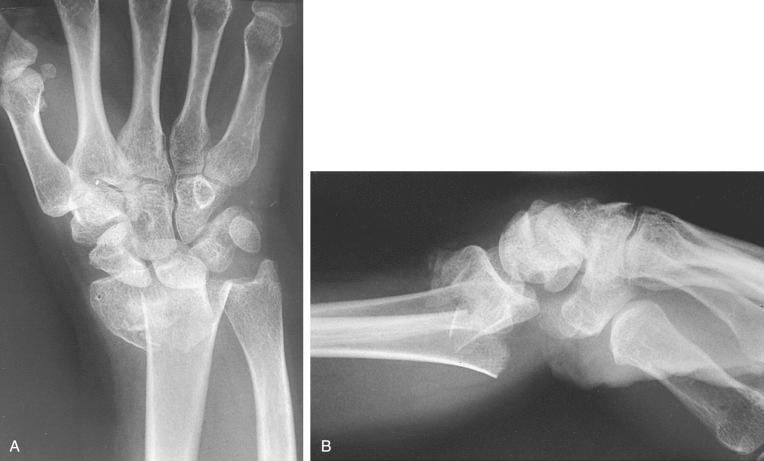
Intraarticular injuries include any fracture that extends into the radiocarpal or radioulnar joint and is displaced more than 1 to 2 mm. These fractures are further subdivided into fractures with two, three, four, and five or more parts.
The most common of the two-part intraarticular fractures are the simple transverse bending fractures, which enter the DRUJ but do not involve the radiocarpal articulation. Although these are often referred to as extraarticular fractures, they do disrupt the sigmoid notch of the distal radius and can lead to dysfunction of the DRUJ (pain and limitation of forearm rotation). DRUJ involvement should not be overlooked in fractures of the distal radius. This is often best appreciated on a hypersupinated anterior-posterior (AP) radiograph, which tends to show the DRUJ in direct profile (see Fig. 42.23 ).
Two-part intraarticular fractures that involve the radiocarpal joint have several common morphologies. These include the dorsal and palmar rim shear fractures, classically referred to as Barton fractures. These are typically associated with radiocarpal subluxation because the carpus often displaces with the smaller marginal shear fragment. The radial styloid (chauffeur's) fracture and the dorsoulnar corner fracture are also in this category. A critical factor regarding these injuries is that the opposite portion of the radiocarpal joint remains intact and therefore in continuity with the remainder of the radius ( Fig. 42.5 ).
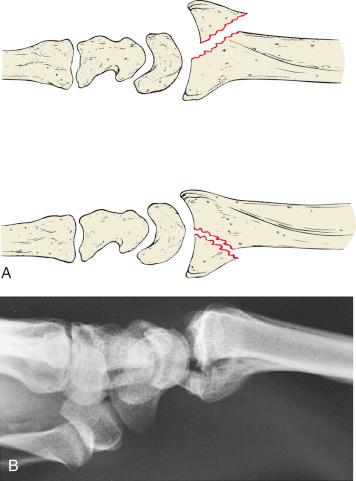
The three-part intraarticular fracture typically involves the lunate and scaphoid facets of the distal radius, which are split by a longitudinal fracture line. These fragments are displaced both from each other and from the proximal radius ( Fig. 42.6 ). The lunate facet is particularly critical because it articulates not only with the radiocarpal joint but also with the DRUJ. This fracture is analogous to the medial complex fracture described by Melone.

The four-part intraarticular fracture is the same fracture as the three-part fracture but with further separation of the lunate facet into dorsal and volar fragments. In general, any displaced intraarticular fracture extending into the lunate facet in the coronal plane (as seen on the lateral radiograph) must also be associated with a fracture extending into the DRUJ ( Fig. 42.7 ). The intraarticular fracture with five or more parts comprises a wide variety of high-energy distal radius fractures.
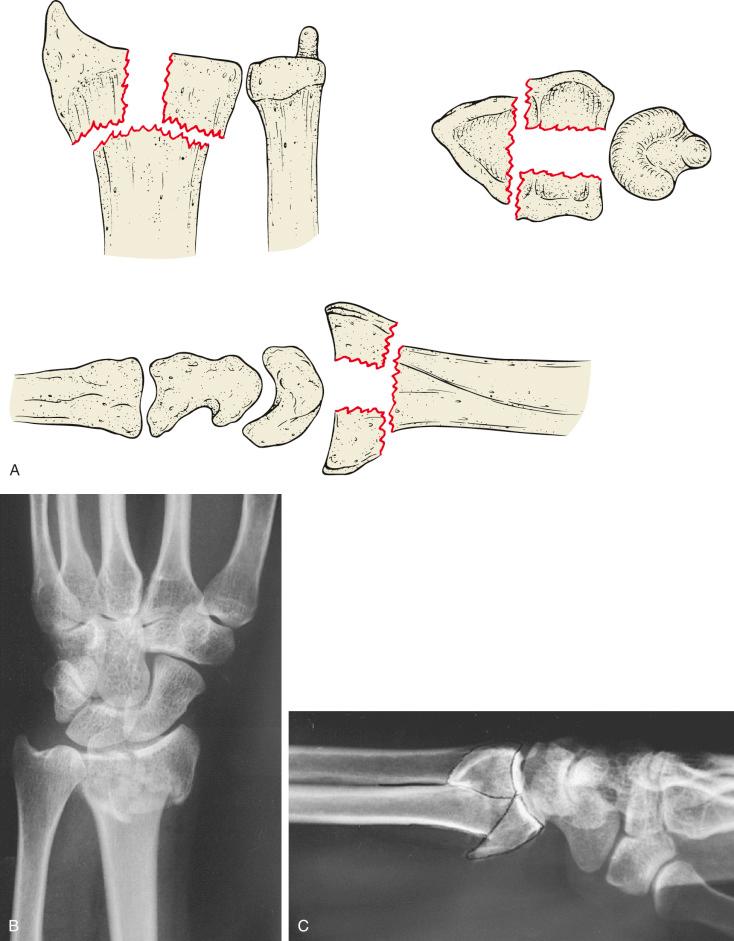
The basic imaging techniques used in the evaluation of distal radius fractures are plain radiography, CT, and fluoroscopic examination. Most distal radius fractures can be adequately assessed with high-quality radiographic views. These are required to define the “personality” of the fracture, which is determined by the degree of initial displacement and the intrinsic stability of the fragments after reduction. The importance of the initial radiographs in the determination of fracture stability is critical. For example, two radius fractures that are perfectly reduced, where one was initially very comminuted and displaced and the other was only slightly angulated, will behave very differently after reduction.
In addition to standard PA and lateral views, an adjusted lateral view directing the beam 20 to 25 degrees from distal to proximal improves visualization of the distal radius articular surface. The partially supinated oblique PA view allows evaluation of the dorsal facet of the lunate fossa ( Fig. 42.8 ). The partially pronated oblique PA view best projects the radial styloid ( Fig. 42.9 ). Oblique views frequently reveal intraarticular extension or displacement not appreciated on standard frontal and lateral projections. The DRUJ is frequently not in direct profile on standard PA projections. Transverse metaphyseal fractures of the distal radius often exit at the DRUJ, and the only clue to step-off at the joint will be a step-off on the radial side until a hypersupinated radiograph or a true neutral rotation PA projection is obtained with the DRUJ in direct profile, demonstrating the displacement (see Fig. 42.23 ). The importance of good-quality radiographs (out of a splint if necessary) cannot be overemphasized in planning treatment. Inadequate radiographs and subsequent poor fracture characterization have contributed, in part, to the difficulty in comparing results among various treatment methods for these injuries.
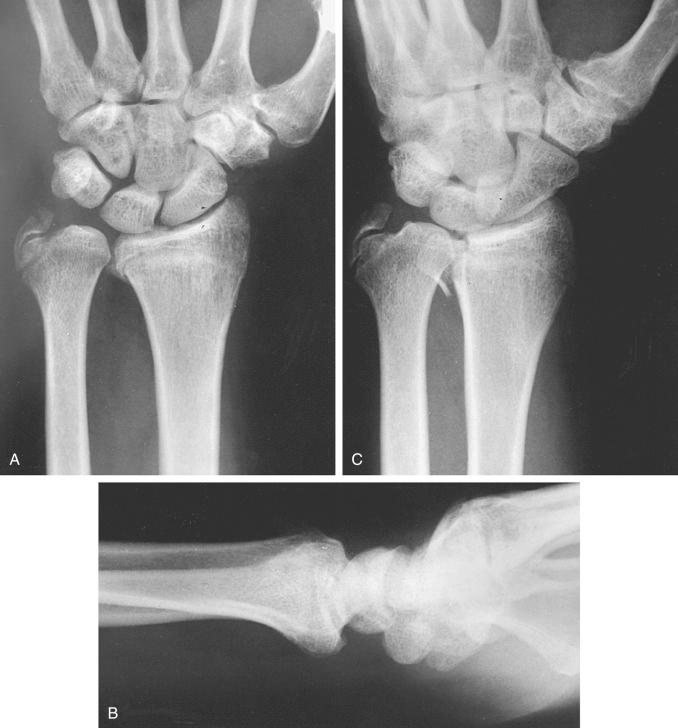
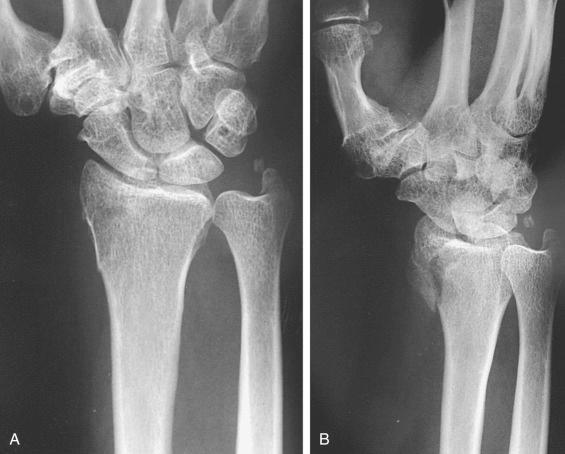
Computed tomography can be valuable in accurately defining anatomic disruption, particularly for intraarticular fractures with multiple components. This technique permits a clear definition of the fragments and their displacement. Often, centrally impacted fragments cannot be appreciated on plain radiographs. Sagittal and coronal reformatted views allow clear visualization of these fragments and almost always reveal greater comminution and displacement than can be appreciated on plain radiographs ( Fig. 42.10 ). The modernization of many viewing software programs for CT scans has also allowed for not only three-dimensional (3-D) reconstruction views but also the ability to subtract structures that may block full visualization of the fracture fragments. For distal radius fractures, this scenario is most common when subtraction of the carpus and hand may allow more complete visualization of intraarticular fracture fragments. The use of such imaging can greatly enhance the surgeon's understanding of certain fracture patterns ( Fig. 42.11 ).
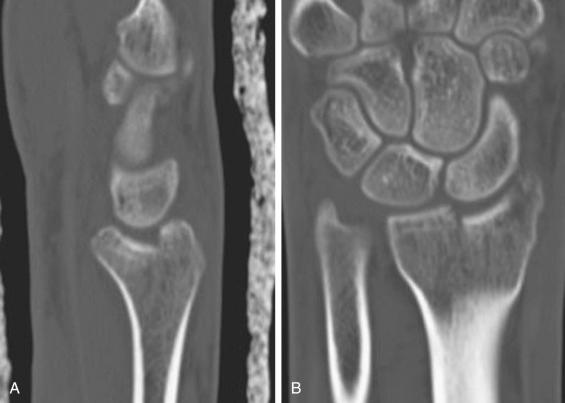
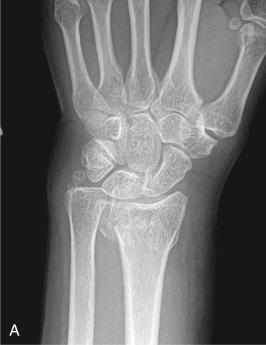
Most distal radius fractures can be reduced initially by manipulative closed reduction. This technique uses ligamentotaxis (fracture reduction through intact ligaments) to restore anatomic relationships. Fractures caused by a bending and/or shearing mechanism have a high probability of reducing with ligamentotaxis given their capsular attachment to the carpus, whereas central impaction injuries often will not. The stability of a fracture is best defined as its ability to resist displacement after it has been manipulated into an anatomic position. In addition to the anatomic type, a number of local factors contribute to fracture stability, including the degree of metaphyseal comminution, the quality of the bone, the energy of the injury, and the degree of initial displacement.
Comminution tends to increase with both the energy of the injury and the patient's age. The extent of cortical comminution is of particular importance in predicting the intrinsic stability of fracture reduction. Decreased bone density, seen most often in patients of advanced age, especially postmenopausal women, increases the fracture's tendency to shorten and collapse and weakens the interface with implants. For example, the combination of a dorsal bending mechanism with substantial dorsal comminution creates an environment at high risk for collapse even after reduction. The difficulty of maintaining reduction with casting or nonrigid internal fixation influences treatment decisions in this group of patients.
The energy imparted to the bone and soft tissues at the time of injury also affects fracture stability. Fractures of the distal radius most often result from a fall on the outstretched hand and involve relatively low energy. These, as previously noted, are found more frequently in postmenopausal women with localized or generalized osteoporosis. In contrast, young adults tend to incur high-energy injuries, which correspondingly present unique difficulties in management. Greater degrees of displacement, articular impaction, neurovascular compromise, and soft tissue stripping are present with high-energy injuries and create fractures with increased potential instability that require careful attention to the bone and soft tissues.
LaFontaine and associates suggested five factors that indicate instability of distal radius fractures: (1) initial dorsal angulation greater than 20 degrees, (2) dorsal metaphyseal comminution, (3) radiocarpal intraarticular involvement, (4) associated ulnar fractures, and (5) patient age older than 60 years. These criteria have been further examined, and it has been determined that they, in total, are effective at predicting final radial height, inclination, and ulnar variance but not volar tilt or carpal malalignment. However, the ability to “hook” or reduce the volar cortical contact at the time of initial reduction did correlate with both improved final volar tilt and carpal alignment and should be considered an additional predictor of stability. A systematic review identified female gender, age over 60, and dorsal comminution to be the three greatest predictors of loss of reduction, whereas intraarticular involvement and a concomitant ulna fracture were not adequate predictors. It is clear from this discussion that absolute guidelines with respect to fracture stability have yet to be established. Each local factor contributes to stability, and a judgment must be made with respect to the ability to maintain fracture reduction in a splint or cast. Borderline fractures treated nonoperatively must be observed closely with repeat radiographs to evaluate displacement.
Loading patterns across the wrist are affected by very minor changes in distal radial geometry. Axial loads at the radiocarpal joint are normally distributed primarily onto the radius (82%), with additional loading at the distal ulna through the triangular fibrocartilage complex (TFCC) (18%). At approximately 10 degrees of dorsal tilt of the distal radius, the load bearing across the radiocarpal joint begins to change significantly. For example, at 20 degrees of dorsal tilt, the ulna bears 50% of the load, and the radiocarpal forces become dorsally shifted and concentrated at the scaphoid articular facet. At 45 degrees of dorsal tilt, the ulna bears 67% of the axial load across the wrist. As little as 2.5 mm of radial shortening also significantly shifts force loading to the distal ulna (from 18% to 42% of total load). This additionally disturbs the relationships and the forces at the DRUJ, which can manifest as pain and limitation in forearm rotation (in addition to ulnocarpal impingement). These biomechanical parameters support the need for more aggressive approaches to restore anatomic relationships after fracture of the end of the radius.
Several contemporary prospective studies have focused on the relation between anatomy and function. Howard and coworkers, in a study comparing external fixation and plaster immobilization, found that functional results had a significant relation to the quality of the anatomic restoration and were less influenced by the method of immobilization. These findings were confirmed in additional prospective studies by van der Linden and Ericson, Porter and Stockley, and Jenkins and associates. In each of these studies, function, as reflected in grip strength and endurance, was impaired if the fracture healed with more than 20 degrees of dorsal angulation or less than 10 degrees of radial inclination. Radial shortening was associated in some cases with disruption of the DRUJ. Overall, a number of studies have suggested a direct relation between residual deformity and disability, especially in younger, higher-demand patients.
Residual intraarticular incongruence also has implications for late functional results and the development of degenerative arthrosis. Although mild articular involvement in low-energy fractures in older postmenopausal women has little impact on the generally favorable outcome found with these patients, this is not necessarily the case in younger, more vigorous persons. Impacted intraarticular fractures have received more attention in recent years because failure to reduce these fractures to within 2 mm of articular congruity, especially in young adults, will probably lead to symptomatic posttraumatic arthritis.
Articular impaction fractures in younger patients are more often the result of high-energy trauma and can be associated with a spectrum of injuries, including carpal instability, disruption of the DRUJ, and local soft tissue trauma. With greater understanding of the pathomechanics of these fractures has come the recognition that conventional manipulation or reduction by traction may not adequately reduce many of these impacted or rotated articular fractures and may not restore intracarpal ligament dissociations.
A number of studies have highlighted the importance of the DRUJ in the overall functional outcome after distal radius fracture. This joint can be negatively affected both by ligamentous injury from the acute trauma and by residual deformity of the distal radius. The treatment of chronic instability, malalignment, or degenerative changes at the DRUJ after distal radius is challenging and must be tailored on a case-by-case basis, with options ranging from corrective osteotomy of the radius to improve alignment, to DRUJ ligament reconstruction to combat instability, to salvage options such as a partial or complete resection of the distal ulna or implant arthroplasty to treat degenerative disease. These procedures have varying degrees of success, and thus it is critical to identify and treat DRUJ pathology early on to avoid these sequelae.
Controversy exists regarding the precise relation between distal radius residual deformity and functional results in the elderly and lower-demand population. It is well recognized that adequate and painless wrist function can coexist with radiographic deformity in certain individuals. However, even studies that have observed successful outcomes that did not correlate with anatomic restoration have noted that objective results may be inferior to the subjective results.
Evidence continues to mount over the past decade supporting nonsurgical treatment for even displaced and unstable fractures of the distal radius in the elderly population, especially extra-articular injuries. In a randomized controlled trial (RCT), Arora and colleagues compared nonoperative treatment versus volar fixed-angle plating in patients older than 65 years and found improved function in the operative group in the early postoperative period and improved grip strength at all time points. However, a higher complication rate and no differences in pain, functional scores, or range of motion (ROM) were observed at 1 year. Diaz-Garcia and colleagues, in a meta-analysis of 21 high-quality studies comparing cast immobilization with multiple surgical treatment types, found statistical differences in ROM and functional scores. However, the differences were quantitatively small and deemed likely not clinically relevant. The complication rates were higher in the operative groups, with most major complications due to volar fixed-angle devices, largely caused by tendon rupture or adhesions. However, Martinez-Mendez and colleagues, in a randomized study assessing cast treatment versus volar plating specifically for displaced intraarticular fractures in the elderly, found better functional outcomes and quality of life after volar plating and good outcomes correlated with restoration of the articular surface, inclination, and ulnar variance but not with articular step-off.
Given the fact that most distal radius fractures occur either in young patients with the potential for remodeling or in older patients with generally lower functional demands, it is not surprising that in most large clinical series, the majority of patients do relatively well.
Problems do exist, however, particularly with high-demand patients. Bacorn and Kurtzke evaluated a large number of patients with work-related distal radius fractures and found an average disability of 24% of the involved limb and no disability at all in only 3% of cases.
Before considering the treatment of the fracture itself, all patients with distal radius fractures should be considered for possible bone density workup and treatment, especially perimenopausal women. High-risk patients include all those older than 65 years of age; middle-aged women; and younger patients with chronic disease processes such as a history of transplantation, chronic renal disease, or immobility for any reason. The incidence of hip fracture within the first year after distal radius fracture in patients over 60 years old is nearly six times greater than in control participants without fracture and is highest at 17 times the risk within the first month, likely because of a combination of fall risk and bone density. Simply recommending workup for decreased bone mineral density is often not sufficient because compliance can be quite low. Rather, initiation of an integrated model of care incorporating endocrinology referral, a patient educator, and phone follow-up was found to increase screening rates from 15% to 80%. Younger individuals may also be at risk. Rozenthal and colleagues compared bone density in premenopausal women who had radius fractures with control participants and found decreased bone density in the patients with fractures. With increasing awareness of vitamin D deficiency and suboptimal bone health, density assessment must be considered when evaluating these individuals. The importance of this screening pertains to men as well as women. Harper and colleagues found that in a large cohort of distal radius fracture patients over the age of 50, only 18% of men versus 53% of women underwent bone density testing after their fracture, and half of those men tested were positive for osteoporosis. Rates of osteoporosis have been reported as 17% in men aged 40 to 64 and 23% in men over 65 years old with distal radius fractures.
Theoretical concerns exist with starting bisphosphonate treatment soon after a fracture is sustained. However, in a randomized trial, Gong and colleagues found no disadvantage to starting bisphosphonates at 2 weeks after fracture compared with at 3 months. In fact, in a comparative study, Shoji and colleagues found no differences in fracture healing or outcomes whether or not patients with surgical distal radius fractures were actively undergoing bisphosphonate therapy throughout the treatment course for their distal radius fracture. It also appears that, fortunately, the presence of osteoporosis likely does not create an increased risk of fixation failure after volar locked plating or lead to worsened clinical outcomes.
The initial selection of treatment options after fracture of the distal radius must be made in the context of the patient's needs and functional requirements. Similar fractures in the dominant wrist of a 20-year-old athlete and in the nondominant wrist of a 72-year-old nursing home patient do not necessarily dictate similar treatment. Patient evaluation should take into consideration a combination of age, occupation, handedness, and lifestyle requirements. It must not be based solely on the chronologic age of the patient. The patient's psychological outlook and associated medical conditions should also be considered.
The workup of a patient with a distal radius fracture should consist of a careful medical history, general physical examination, and routine laboratory testing. The coexistence of life-threatening injuries or long-standing systemic illnesses may represent a relative contraindication for more invasive management. A history of substance abuse or recurrent poor compliance also represents a relative contraindication to complicated treatment options. Appropriate treatment requires matching a patient's needs and the character of the fracture with the best treatment alternative.
The methods for treatment of fractures of the distal radius most simply include above-elbow and below-elbow cast immobilization, percutaneous pins and cast immobilization, external fixation with or without percutaneous pins, and limited or formal open reduction. The options for internal fixation have evolved in recent years, with dorsal plating being largely replaced by volar fixed-angle fixation for most fractures. Arthroscopically assisted reduction, fragment-specific fixation, and dorsal bridge plating have roles in certain fracture types as well. In dealing with complex fractures, a combination of these methods may be required.
It is important to note that over the past 10 to 20 years, there has been a major shift in the way distal radius fractures are treated worldwide toward operative management and specifically internal fixation. Wilcke and colleagues, in a large Swedish database study of more than 42,000 patients, found that between just 2004 and 2010, the number of surgical procedures for distal radius fractures increased 40% despite a decreased incidence of injury. Over the same period, adult patients treated with plate fixation increased from 16% to 70%, with an almost equal drop in the use of external fixation. Similarly, Mattila and colleagues, in a Finnish database study of more than 14,000 distal radius operations between 1998 and 2008, found that the incidence of plating nearly doubled over the study period. This highlights the current shift away from external fixation toward internal plate fixation for these injuries. It has also been shown that young surgeon age and even certain surgeon personality factors lead a surgeon to recommend open reduction and internal fixation (ORIF) over nonoperative treatment or simpler fixation techniques.
Closed reduction with cast immobilization remains an acceptable method of treatment for most fractures that are considered acceptably positioned and inherently stable. Stable fractures are generally those that are undisplaced or only minimally displaced and impacted at the time of presentation. Fractures with greater displacement but minimal comminution, especially in very young patients, can often be stable after closed reduction and are amenable to cast treatment but require very close observation for loss of reduction. As previously stated, significant initial displacement, older age, and dorsal comminution are signs of fracture instability.
With a stable extraarticular fracture, a simple below-elbow or “sugar-tong” splint molded over the fracture site suffices initially in most patients.
The splint remains in place for the first week after fracture reduction and is then replaced by a short-arm cast in most circumstances.
Care is taken to end the splint proximal to the palmar metacarpophalangeal joint flexor crease. Digital motion is stressed throughout the healing phase.
Follow-up radiographs weekly are recommended to monitor for any displacement within the cast if the fracture has the potential to become unstable.
Because of diminished soft tissue swelling and atrophy from disuse, several new, well-molded casts can be required during the typical 5- to 6-week period of immobilization.
Despite the widespread acceptance of cast immobilization, questions remain as to the optimal position for immobilization and the need to extend support above the elbow. Several studies have addressed these issues in a prospective manner, looking at different positions of the hand and wrist, functional bracing with the forearm in supination versus short arm splints, and long arm versus short arm casts. Neither position of immobilization nor extension above the elbow appeared to influence the anatomic outcome to any noteworthy degree in these studies. This suggests that maintenance of fracture alignment depends mostly on the inherent characteristics of a given fracture (e.g., initial displacement, comminution, bone quality). We therefore tend to favor short arm cast immobilization for stable distal radius fractures.
Despite initial successful closed reduction of displaced fractures, the patient and physician must be aware that 40% of such fractures will lose reduction and go on to surgical intervention. Loss of reduction of fractures during cast or splint immobilization is common, and remanipulation has been reported. Unfortunately, two retrospective studies found displacement to recur in 46% and 67% of cases after remanipulation. A greater likelihood of retaining the reduction was noted in younger patients and in fractures remanipulated between 7 and 15 days after the initial reduction, but the failure rate was still quite substantial. Thus loss of reduction in a cast is a sign of fracture instability, and consideration should be given to more aggressive treatment if warranted by the patient's functional requirements.
A number of treatment options exist to offset the loss of reduction in an unstable extraarticular distal radius fracture in a patient in whom the maintenance of anatomic position is deemed important. These include percutaneous pinning of the distal fragment, external skeletal fixation devices, and ORIF. The development of anteriorly applied locking plates is currently the most commonly used surgical method. Intramedullary nailing, however, deserves mention as a minimally invasive treatment method for which adequate radiographic and functional results have been reported in such cases.
Become a Clinical Tree membership for Full access and enjoy Unlimited articles
If you are a member. Log in here